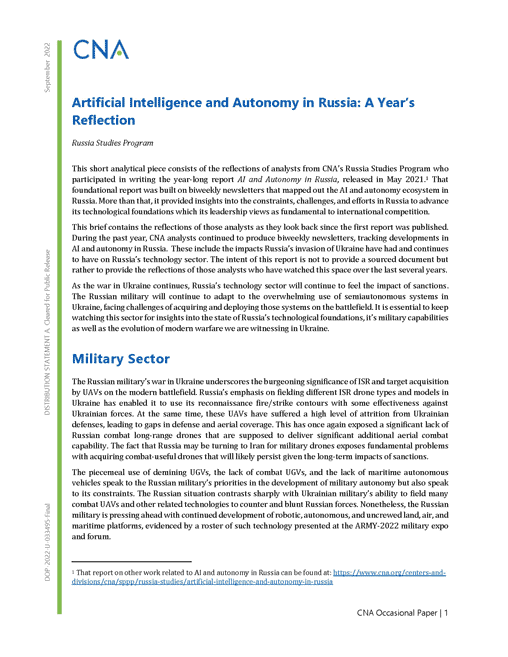This short analytical piece consists of the reflections of analysts from CNA’s Russia Studies Program who participated in writing the year-long report AI and Autonomy in Russia, released in May 2021. That foundational report was built on biweekly newsletters that mapped out the AI and autonomy ecosystem in Russia. More than that, it provided insights into the constraints, challenges, and efforts in Russia to advance its technological foundations which its leadership views as fundamental to international competition.
This brief contains the reflections of those analysts as they look back since the first report was published. During the past year, CNA analysts continued to produce biweekly newsletters, tracking developments in AI and autonomy in Russia. These include the impacts Russia’s invasion of Ukraine have had and continues to have on Russia’s technology sector. The intent of this report is not to provide a sourced document but rather to provide the reflections of those analysts who have watched this space over the last several years.
As the war in Ukraine continues, Russia’s technology sector will continue to feel the impact of sanctions. The Russian military will continue to adapt to the overwhelming use of semiautonomous systems in Ukraine, facing challenges of acquiring and deploying those systems on the battlefield. It is essential to keep watching this sector for insights into the state of Russia’s technological foundations, it’s military capabilities as well as the evolution of modern warfare we are witnessing in Ukraine.
Military Sector
The Russian military’s war in Ukraine underscores the burgeoning significance of ISR and target acquisition by UAVs on the modern battlefield. Russia’s emphasis on fielding different ISR drone types and models in Ukraine has enabled it to use its reconnaissance fire/strike contours with some effectiveness against Ukrainian forces. At the same time, these UAVs have suffered a high level of attrition from Ukrainian defenses, leading to gaps in defense and aerial coverage. This has once again exposed a significant lack of Russian combat long-range drones that are supposed to deliver significant additional aerial combat capability. The fact that Russia may be turning to Iran for military drones exposes fundamental problems with acquiring combat-useful drones that will likely persist given the long-term impacts of sanctions.
The piecemeal use of demining UGVs, the lack of combat UGVs, and the lack of maritime autonomous vehicles speak to the Russian military’s priorities in the development of military autonomy but also speak to its constraints. The Russian situation contrasts sharply with Ukrainian military’s ability to field many combat UAVs and other related technologies to counter and blunt Russian forces. Nonetheless, the Russian military is pressing ahead with continued development of robotic, autonomous, and uncrewed land, air, and maritime platforms, evidenced by a roster of such technology presented at the ARMY-2022 military expo and forum.
Before the war Russia placed significant emphasis on AI in decision-making and data analysis across its weapons systems and platforms; however, open-source data collection has not identified the use of AI and/or ML in Russian military activity in Ukraine. Admittedly this is also more difficult given the nature of AI and its lack of usual visual indicators. The international sanctions imposed on the Russian Federation, the ongoing and uneven import-substitution, and the government’s efforts to re-direct and manage the fallout from the sanctions and substitutions on the domestic high-tech and defense ecosystems will have a lasting effect on Russia’s ability to develop and field the above-mentioned weapons and systems.
At the same time, the Russian military’s widespread use of commercial technology, such as DJI Mavic drones for ISR, target acquisition/coordination, and munitions-dropping roles in this conflict, and the Ukrainian military’s adaptation of the same technology to successfully identify and target Russian forces, will have a lasting effect on the way the Russian military uses and trains with UAVs and aerial drones. The volunteer-led effort to deliver such technology and train operators is changing how commercial technology can be applied in conflict.
The Russian defense and civilian establishments have gone ahead with their plans for centralized approaches to AI research, development, testing, evaluation, and fielding. In August 2022, the Russian Ministry of Defense announced the official creation of an AI department for implementing artificial intelligence in weapons development. During the announcement, the MOD discussed the need to consolidate and better manage different AI-related R&D across its departments, research institutions, and defense-industrial corporations. Given statements emphasizing the importance of AI to the Russian MOD, this department may be central in crafting policies and directing actual work. Existing military AI R&D efforts will likely report to this department.
In September 2022, the Russian government launched the National AI Center, charged with implementing the national strategy for the development of artificial intelligence in Russia. This center has a wide range of analytical, practical, expert, and coordination tasks for promoting effective AI solutions for business, science, and the state. The center will regularly monitor key indicators of AI development, will review national regulation, and will provide expert support for the implementation of AI across the private and public sectors.
Download reportDISTRIBUTION STATEMENT A. Cleared for Public Release
Details
- Pages: 6
- Document Number: DOP-2022-U-033495-Final
- Publication Date: 9/19/2022
